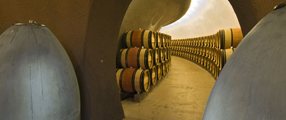Concrete casks for fermenting and curing wine have been used for centuries, but the concrete barrels went out of fashion as stainless steel casks, which are easier to regulate and clean, became more popular. Now not only are the concrete casks coming back into fashion as this unique egg shape gains popularity, many wine makers swear they produce better tasting wine.
The concrete egg cask’s advantages are twofold. First, concrete is a naturally porous material, and similar to oak barrels it allows the wine to oxidize during fermentation, evolving and adding texture but no oaky flavor, while preserving the flavors and aromas similar to wine cured in stainless steel casks. The second advantage comes from the cask’s unique shape. As the wine ferments, the juice moves slowly up the sides of the egg and sinks in the middle due to a naturally occurring circulation by the temperature gradient between the top and the bottom of the cask. Furthermore, there are no dead corners where the juice, seeds and skin get stuck, producing a slow, even fermentation associated with high quality wines.
Wine makers using concrete eggs say wine made in concrete casks has a fuller, rounder and more complex taste. We're not quite sure if these concrete casks would need waterproofing and how that would interact with the oxidation process. One thing for sure is, we wouldn't mind taking this into our concrete permeability laboratory for some testing!
Image source: Janis Miglavs








